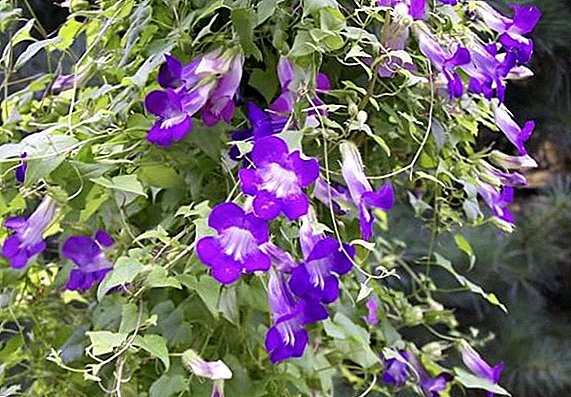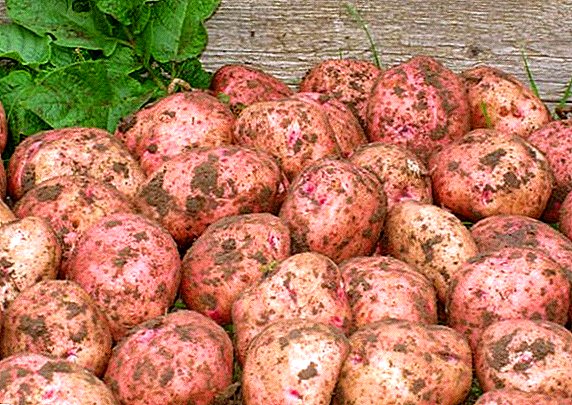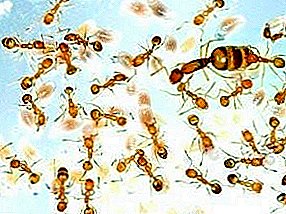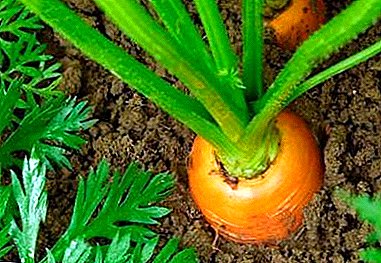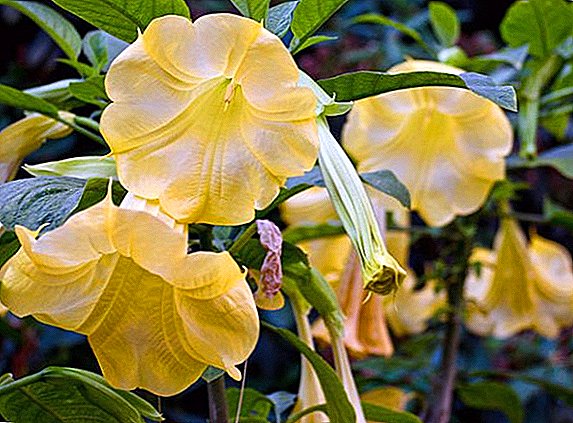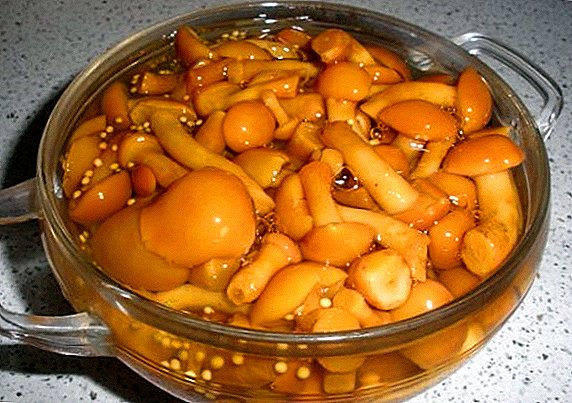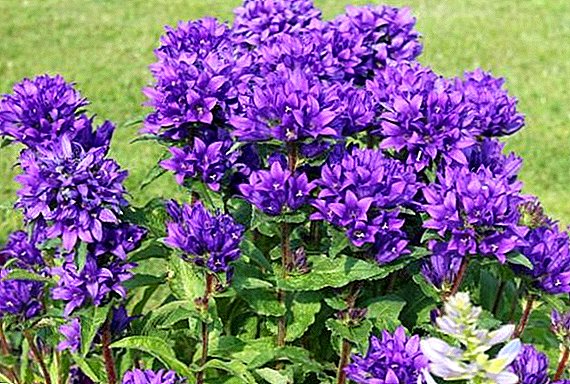 A crowded bell is one of the most beloved flowers of gardeners, its shape resembling bouquets of small bells standing on separate legs. As garden crops, these delicate flowers are different colors and varietal diversity. In this article, we will discuss what garden varieties of a bell are there, how to grow it at home and use it in landscape design.
A crowded bell is one of the most beloved flowers of gardeners, its shape resembling bouquets of small bells standing on separate legs. As garden crops, these delicate flowers are different colors and varietal diversity. In this article, we will discuss what garden varieties of a bell are there, how to grow it at home and use it in landscape design.
Botanical description
The bells are crowded (in Latin Campanula glomerata) have another name - the bells are national teams. This plant of the genus Bell and belonging to the family Kolokolchikovyh.
The Kolokolchikov family also includes such plants as a broadleaf bell, lobelia ampelous, campanula, peachy bell, trachelium, and platicodone.
They have single stems from 20 to 100 centimeters high, covered with silvery fluff, sometimes bare, gray-green or reddish. 
Leaves ovoid or oblong-lanceolate. Flowers light purple, blue, deep purple or white, up to 3 centimeters in length, collected in a spherical inflorescence at the very top of the stems.
The crowded bells are perennials, start flowering from the very beginning of summer and finish in the first half of September. The culture is not demanding to care, resistant to pests, is not sensitive to low temperatures and is able to tolerate a temporary lack of moisture.
The healing properties of this flower are known, therefore in folk medicine it is used as an anti-inflammatory, sedative and anesthetic for headaches, inflammations of the mouth and throat, as well as for a hoarse voice.
Learn how with headaches recommend the use of periwinkle, catnip, brahma herb, linden, ginger, bluebush, peppermint, motherwort herb.
Distribution and habitat
Under natural conditions, these flowers grow everywhere: in forest glades, in the field and in the meadows among the forbs. The areas of these flowers are vast territories: from the Iranian state to Japan, as well as Europe and North America. 
Did you know? The ancient Russian legend says that the flowers of the bells appeared as a result of the merging of the songs of the drivers and the chime of the small bells on the horses drawn in carts. All the surroundings of the villages were announced with these sounds, and where the chimes fell on the ground, these delicate flowers grew.
Popular varieties of crowded bell
There are several varieties of a crowded bell that gardeners love to use in landscape design; they differ among themselves in a different palette of shades. Below we give some varieties of this flower and briefly describe their varietal characteristics.
"Gnome" (Campanula glomerata "Dwarf"). 
The plant is short, 20 centimeters in height, with elongated and heart-shaped, matt leaves covered with fluff. From the stem leaves many processes. The bell "Gnome" has dark purple funnel-shaped flowers, gathered in dense piles.
This variety is surprisingly winter hardy and unpretentious to growth conditions. It should be watered only with prolonged high temperatures. The flower loves lime and complex mineral fertilizers.
To complex mineral fertilizers include such as "Master", "Kemira", "Sudarushka", "AgroMaster", "Plantafol", "Mortar", nitroammofoska, "Crystal"."White" (Campanula glomerata "Alba").

This flower also has a low stem, 20-25 centimeters. White flowers with short pedicels collected in the apical and axillary capitate inflorescences of about 20 pieces. When the inflorescences fade, the stalks fall away with the rosettes of the basal leaves.
Before the old rosettes die, many new ones appear, and flowering continues until autumn. These bells can grow strongly in flowerbeds than they are able to drown out the planting of other flowers.
Plants love a location where there is a lot of sun, and the soil for them should be slightly damp, light and fertilized with humus and lime. White bell looks good in mixborders, in flowerpots and alpine slides.
Carolina (Campanula glomerata Caroline). 
This flower will be a little taller than the two previous brethren, with a height of 30 to 60 centimeters, with pubescent stems and leaves. The leaves have an ovate-oblong or ovate-lanceolate form, with teeth on the edges, on the stem are arranged in turn on both sides.
The flowers can be light purple or blue, two-centimeter in diameter, made up in apical axillary capitate inflorescences numbering up to 20 pieces.
Flowering lasts from June to July for 35 days in open and sunny places. Bells "Carolina" prefer loose, light and fertilized soil. Usually they are planted in mixborders or planting in groups, as well as for cutting.
Blue (Campanula glomerata "Blue"). 
The height of these bells reaches from 30 to 60 centimeters. They have erect, bare or pubescent stems, on which smooth and elliptical leaves grow. Bell-shaped, two-centimeter flowers of bright blue color, on top of the stems are combined into inflorescences up to 6 centimeters in length, in the form of a ball.
Blue bell blooms in June and blooms for two months. He likes good lighting, acceptable and partial shade. The soil should be neutral, fertile and drained. The plant does not tolerate lowlands. In winter, it is hardy, to the growing conditions and to the soil - no complaints.
"Bellefleur Blue", blue (Campanula glomerata "Bellefleur blue") and "Bellefleur vayt", white (Campanula glomerata "Bellefleur white"). 
These are two color varieties of one variety of a bell crowded with white and blue bell-shaped inflorescences. Stems are from 20 to 25 centimeters high, erect, bare or in fluff hairs. On the stems are elliptical sheets with a smooth surface.
The flowers are arranged in the form of spherical inflorescences. Flowering period - from June to August. The grade - frost-resistant, is suitable for disembarkation in containers or flowerpots to 3 liters.
Did you know? The first church bell was cast from copper in 1500 in the province of Campania, in Italy. According to legend, the local bishop Paulinius, walking around his village, drew attention to the bells growing everywhere. And it even seemed to him that when the wind was blowing they swayed and made a gentle ring. After that, he ordered to make the first copper flower-bell.
Blue or prefab blue "Superba" (Campanula glomerata "Superba"). 
Perennial with stems from 40 to 60 centimeters tall, with bright, blue-violet flowers in diameter up to 2.5 cm, forming capitated inflorescences. Leaves are dark green, smooth, elliptical, having small setae below. The flowering period is July-August.
Blossoming plentiful and long. Frost-resistant. The plant loves both lighted areas of beds, and partial shade. The soil requires fertile, neutral or slightly acidic, with good drainage and moisture.
The bells of this variety look good in rockeries, on Moorish lawns, in rabatkah, as well as in the form of curb fences. Due to the rich blue color they look beautiful in rosaries.
Use in landscape design
Due to the fact that all varieties of crowded bell are very decorative, they are used with pleasure in landscape design in garden plots, as well as in parks and squares in the urban area. 
The bells can be used for any mixed plantings, as they can bring pieces of touching tenderness and simplicity into any compositions with their romantic flowers.
For example:
- higher varieties, such as "Carolina", "Blue", "Superba", are better planted in the most central part of the flower beds or bedding, they will also look spectacular under the canopy of trees;
- those bells that are smaller (Belle Blut, Belfleur White, etc.) can be used in group plantings, in the form of borders, placed on a rocky hill and in the thickets of roses;
- even the farthest corners of the garden can be decorated with tall plants, creating fringing strokes of the plot. It will be advantageous to look at a combination of bells of different shades, for example, white and dark purple;
- Alpine hills and rock arias can be decorated with low varieties, where alternating bright blue, white, purple and blue shades against the background of decorative stones will create a wonderful mood;
- in the landscape design of the garden plot or park, the bell crowded perfectly combines with other "neighbors": stonecrop, Veronica, Zelenchuk, yasnotkoy, daisies, pansies, nivyanik and cereals.

Important! Note that the bells planted in the shaded corners of the garden will have larger flowers, but the plants will bloom a little later.
Growing at home
When growing a bell crowded at home, there is no particular difficulty, as this flower is unpretentious and can adapt to any conditions of life. It is important to remember that large buds, their long flowering and decorative appearance throughout the warm period depend on the creation of comfortable conditions for the culture.
Therefore, if you observe all the subtleties of growing bells at home, good results can be achieved. Further we will talk about these subtleties.
Conditions of detention
As we have said, the conditions for growing this garden crop are not difficult. 
It is only important to observe the following measures:
- bells are preferable to grow in open, sunny areas or slightly shaded areas;
- It is possible to plant flowers not only directly on a bed, but also in plastic containers or vases of 1 to 3 liters;
- these flowers love to grow well, so they need to be planted at an optimal distance from each other (the distance will be indicated below);
- if the plant has grown strongly, then every 4 years it is necessary to divide the bushes into delenki and plant the planting material, observing the necessary distance between the plants;
- in the area where you are going to plant bells, there should be no stagnant moisture. This culture does not like overmoistening of the soil, therefore lowland places will not be suitable for it;
- plants do not like the presence of weeds, so it is important to regularly weed and loosen the soil;
- if you remove the flower stalks that have faded from the bells in time, you can prolong the beauty and flowering period;
- the culture is resistant to severe frosts, and therefore does not require additional shelter in the winter.

Soil and fertilizer
The composition of the soil bells crowded not very demanding, so they can grow on any soil.
Yet there are a number of basic rules:
- Neutral or weakly alkaline soils are best for planting crops;
- in no case can not be planted flowers in clay soils with close groundwater flow, otherwise in winter the plants are at risk of freezing;
- the bell will grow well and develop also on loamy soils;
- if you have a heavy black soil at the site, it can be diluted with humus and sand. If the soil is poorer, then add turf soil and fertilizer to it.

Now let's talk directly about fertilizers suitable for growing bells:
- your flowers will perfectly respond to the introduction of rotted manure and superphosphate into the soil;
- it is not recommended to bring fresh manure and peat into the soil for plants, as this threatens them with fungal diseases;
- if the soil in your area is fertile, it is enough sometimes to add wood ash to it. This advice is also suitable for a soil with a weak acid reaction;
- it is necessary to fertilize the soil on the basis of: no more than 5-10 g of mineral fertilizers per meter linear;
- top dressing of a plant should be carried out three times a season: before the beginning of flowering, during the period of blooming and after.
Important! Do not overdo it with fertilizer soil for bells, so that it does not give a strong growth of the shoots, from which their flowering may suffer.

Watering and moisture
For bells, a temporary lack of moisture is not terrible, the main thing is to remember that plants cannot be subjected to prolonged drought. Watering should be moderate, as the soil dries. 
Breeding
There are two ways of breeding this plant:
- seeds;
- vegetatively.
Take a closer look at both of these methods.
Seeds
For planting seed bells have the following requirements:
- it is necessary to collect planting material immediately after the boll matures, shaking out seeds from it and preventing them from self-dispersing;
- seed should be sown in early spring in a greenhouse or in open ground in warm weather (depending on climatic conditions) - May, June, July, August.
Now the process of planting seeds:
- Dig up the soil well.
- Dig shallow holes at a distance of at least 15-20 cm from one another.
- Each hole must be watered.
- Deepen the seeds to a depth of 5 cm.
- Smooth the ground in the hole and pour it again.

If you sow the seeds in a well-lit place, then after two weeks the bells will germinate, and if in the shade, then it will take another week. Although seed germination is usually good, young plants can bloom only for the next season.
Important! To simplify the process of planting seeds and obtain a uniform germination, sifted dry sand is added to the seeds.
Vegetative
A faster propagation of bluebells is vegetative, in which a 3-4-year-old bush is divided into separate parts. There is another way - grafting. Now we will tell about each method separately. 
The division into parts is as follows:
- In early May or in the last decade of August (the beginning and end of the growing season) it is necessary to dig out mother bushes.
- To reduce water transpiration and improve the rooting of future individual plants on uterine bushes, all shoots should be cut off.
- Divide the rhizomes into parts.
- To land the resulting delenki in prepared wells, without unnecessarily digging the plants into the ground.
- Water the planting material.
- If you want to divide the main bushes into smaller parts, then you can plant them not in the ground, but in containers for growing to the desired size.
The cutting is done like this:
- Cut from the shoots of bellflower cuttings of 3 cm, so that each of them had 1-2 buds.
- Dry cuts for 30 minutes.
- Fill with washed perlite or with a mixture of sand and peat a multi-cell plate for planting material.
- Plant cuttings of 3 plants per cell.
- Water the seedlings with a weak solution of potassium permanganate. Watering should not be frequent, as the soil moisture is well preserved under polyethylene, and spraying - periodic. The root system of the cuttings is fully formed in 20 days.

Relation to temperature
Virtually all types of bell crowded winter-hardy, while maintaining low temperatures down to minus 40 degrees. In the more southern latitudes, plants for the winter can not be covered.
If in your region the winters are harsh, then in the fall, in order to prevent the flowers from freezing, the bushes cut by the root can be poured with dry leaves or peat, and you can also cover them with spruce leaves.
Possible difficulties in growing
Special difficulties in growing these flowers are not observed. In addition to the above requirements for illumination, moisture and temperature regimes, these plants need regular weeding, loosening the soil, as well as the timely removal of faded shoots.
Another thing you need to pay attention to when growing this crop is diseases and pests. 
Pests, diseases and prevention
It can be said that the bell clouded is resistant to diseases and harmful insects.
But if plants grow for a long time in the same place in your garden, then there is a threat of such diseases as:
- fusarium - focal disease of plants caused by fungi of the genus Fusarium. The source of infection is affected soil and seeds. In this disease, the root collar and the roots themselves rot. Fabrics become brown, the stem becomes thinner, the leaves begin to turn yellow, after which the plant dies. Fusarium control method - treatment of flowering plants with fungicides containing azoles, for example, "Fundazole";
- sclerotinia, or white rot - these are marsupials, striking white flowers, stem and leaves. The source of infection is contaminated soil. Measures to combat the disease will be to observe crop rotation, digging up the soil in the fall and destroying diseased plants;
- botrytiosis, or gray rot - microscopic botrytis mushrooms. Symptoms of defeat - the leaves of plants are completely covered with spots containing spores of the fungus. A preventive measure can be spraying every 14 days with a mixture of 2 g of copper sulphate and 20 g of green soap (insecticide against pests). The use of 1.5% Bordeaux liquid will also be effective.

There are also such enemies of bells as harmful insects:
- leaf-eating caterpillars;
- spider mite;
- slobbering penny;
- slugs
From each pest there are insecticidal preparations that can be purchased in specialized stores.
Summing up the above, we emphasize that if you follow all simple measures for planting, caring for and preventing diseases in crowded bells, these unpretentious plants are perfect for lovers of ornamental garden crops who do not have much time to constantly care for their garden.



